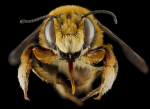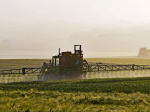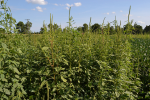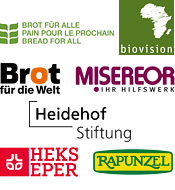News
29.03.2017
EU clears DuPont-Dow merger, despite concerns raised by civil society

The European Commission has approved a merger between agribusiness giants Dow Chemical and Du Pont, despite warnings of civil society organisations that this would be a threat to farmers, consumers, the environment, and food security. On Monday, the EU regulators gave green light for the $130bn mega-merger, the first in a new round of agribusiness takeovers which also includes the planned mergers between Syngenta and ChemChina as well as Monsanto and Bayer. The Commission cleared the deal on the condition that DuPont will sell off large parts of its global pesticides business.
On Monday, more than 200 organisations sent an open letter to Competition Commissioner Margrethe Vestager, calling on the European Commission to reject the impending mergers of the world’s biggest agrochemical and seed companies in an already concentrated market. The farmers’, beekeeper, religious, international development, and environmental groups warn that the proposed mergers of Dow Chemical with DuPont, Monsanto with Bayer AG, and Syngenta with ChemChina will lead to an unacceptable monopoly, with three companies controlling around 70% of the world's agro-chemicals and more than 60% of commercial seeds. “Approving these mergers works completely against the rights of peasants, with far reaching effects in our society,” said Ramona Duminicioiu of the farmer organization “European Coordination Via Campesina” in a press release. “The already fragile rights of peasants regarding seeds, land and markets risks of being obliterated by these mega-corporations.” The organisations fear that increased market dominance would further restrict the diversity of seeds, harm farmers’ freedom of choice and their rights to save their seeds. They said that more market control would also reduce the food choices of European consumers.
In their letter, the organisations also warn that these mergers risk major monopoly outcomes that would further increase the use of agrochemicals. The result would be reduced diversity of farming and a greater dominance of monoculture farming with its heavy reliance on chemical inputs, which would further harm the environment, biodiversity, and human health. “Europe's food and farming system is broken and if giant firms, like Monsanto and Bayer, are allowed to merge they will have an even tighter toxic grip on our food,” said Adrian Bebb of Friends of the Earth Europe. “The mergers are a marriage made in hell and should be blocked by regulators,” he added. “We need to build a fairer and greener food system out of corporate control.” The Commission said it was concerned that the Dow-DuPont merger would have reduced competition for existing pesticides in a number of EU countries. “We were only able to agree to it, because the companies offered to sell off a significant part of their business, to preserve effective competition,” said Commissioner Margrethe Vestager. (ab)
27.03.2017
Transition needed to meet the soaring U.S. demand for organic food

Despite the rapid growth in recent years, U.S. production of organic food lags behind consumer demand, according to a new report released by Environmental Working Group. The U.S. environmental organization argues that even modest reforms to existing federal programs would help farmers transition away from the current form of agriculture with its reliance on pesticides and expand the acreage dedicated to organic agriculture. “Driven in large part by the multiple environmental and health benefits, Americans’ appetites for organic food is seemingly insatiable,” said Colin O'Neil, EWG’s agriculture policy director and author of the report. Between 1997 and 2015, sales in the organic sector have grown from $3.7 billion to more than $43 billion. This double-digit growth nearly every year makes the organic sector one of the fastest growing segments of the food industry. Organic food sales now represent 5 percent of total U.S. food sales. However, US production does not meet the growing demand for organic food, the report shows. Major retailers such as Costco report that they can’t get enough organic food to meet customer demand.
According to analysis by the Organic Trade Association of data from the USDA’s Global Agricultural Trade System, in 2014 the U.S. imported roughly $1.2 billion worth of organic products. Organic exports were only $550 million. While some of the most heavily imported organic products tend to be foods grown in tropical and sub-tropical climates, such as coffee, bananas, olive oil and avocados, many American organic food companies have to turn to foreign suppliers for staples like soybeans, corn and rice – demand that could be met by domestic producers since these crops are ideally suited to U.S. climates. In 2015, the U.S. had to import more than $240 million of organic soybeans. “The current organic trade deficit presents Congress with a unique chance to expand market opportunities for U.S. producers, while also benefitting consumers, food companies and the environment,” said Colin O'Neil. “With modest reforms to current programs in the next farm bill, Congress can reduce barriers to farmers who want to transition organic methods at no additional cost.” One measure could be to embed organic transition into existing conservation programs. Congress and the administration could make better use of tax incentives, small business grants and existing loan programs to also facilitate transition. This would help increasing the number of organic farms and the amount of organic acreage. “The organic trade deficit presents organic businesses, farm groups and Congress with an opportunity to expand market opportunities for U.S. farmers, while at the same time addressing the public health and environmental footprint of American agriculture,” the report concludes. (ab)
24.03.2017
Wastewater is an untapped resource for agriculture, says World Water Report

The vast quantities of domestic, agricultural and industrial wastewater which are discharged into the environment everyday, are an untapped resource, according to the United Nations World Water Development Report. The report, released on March 22 on the occasion of World Water Day, argues that once treated, wastewater offers many benefits for human health and the environment, food and energy security as well as climate change mitigation. The heading of the press release even describes wastewater as the new black gold. However, a large proportion of wastewater is still released into the environment without being either collected or treated. It is estimated that globally, over 80% of all wastewater is discharged without treatment, especially in low-income countries.
“Wastewater is a valuable resource in a world where water is finite and demand is growing,” said Guy Ryder, Chair of UN-Water. “Everyone can do their bit to achieve the Sustainable Development Goal target to halve the proportion of untreated wastewater and increase safe water reuse by 2030. It's all about carefully managing and recycling the water that runs through our homes, factories, farms and cities,” he added. Over the past decades, agricultural water use has increased remarkably. The area equipped for irrigation has more than doubled, from circa 1.4 million km² in 1961 to almost 3.2 million km² in 2012. Total livestock has more than tripled from 7.3 billion units in 1970 to 24.2 billion in 2011. Aquaculture has grown more than twentyfold since the 1980s. Agriculture is by far the largest consumer of the Earth’s available freshwater, accounting for 70% of freshwater withdrawals.
In many countries of the world, wastewater is commonly used for agricultural irrigation. Estimates of the total area that is being irrigated with raw and diluted wastewater range from 5 to 20 million hectares, with the largest share in China. In Jordan, over 90% of treated wastewater is currently being used for irrigation. In Israel, treated wastewater already accounts for nearly half of all water used for irrigation. However, wastewater’s vast potential remains underexploited, especially in Africa.
But the report also warns against the dangers of water pollution, especially from agriculture. Water pollution from agriculture occurs when fertilizers and other agrochemicals are applied more heavily than crops can absorb them or when they are washed away. Nutrients can also be released by livestock production and aquaculture. The report says that agriculture can be a source of several other types of pollutants, including organic matter, pathogens, metals and emerging pollutants. In addition, over the last 20 years, new agricultural pollutants have emerged, such as antibiotics, vaccines, growth promoters and hormones that may be released from livestock and aquaculture farms. There are serious health concerns if water used for irrigation contains pathogens that can contaminate crops.
The report calls for improved wastewater management which includes reducing pollution at the source, removing contaminants from wastewater flows, reusing reclaimed water and recovering useful by-products. Treated wastewater can be a potential source of raw materials such as phosphorus and nitrates that can be turned into fertilizer. According to FAO estimates, 22% of global demand for phosphorus, a finite and depleting mineral resource, could be met by reusing treated wastewater. “In a world where demands for freshwater are continuously growing, and where limited water resources are increasingly stressed by over-abstraction, pollution and climate change, neglecting the opportunities arising from improved wastewater management is nothing less than unthinkable,” the report concludes. (ab)
14.03.2017
One in four North American bee species at risk of extinction, report warns

One in four North American bee species are at risk of extinction due to threats such as habitat loss and pesticide use, new research shows. According to a report released by the Center for Biological Diversity, a US-based conservation organisation, population levels of more than 700 of the 4,000 native bee species in North America and Hawaii are declining at an alarming rate. The main drivers are habitat loss, heavy pesticide use, climate change and urbanization, the study found. To assess current population trends, the researchers reviewed the current conservation status of 316 species as established by state, federal or independent research and then conducted a comprehensive review of all available literature on native bees to determine a status for a further 1,121 species. They concluded that of the 1,437 native bee species for which sufficient data was available, about 749 or more than half were declining. According to the scientists, 347 native bee species – nearly one in four – are imperiled and at increasing risk of extinction.
The report says that a primary driver of these declines is agricultural intensification, which includes habitat destruction, widespread planting of monocultures and toxic pesticide use. “The evidence is overwhelming that hundreds of the native bees we depend on for ecosystem stability, as well as pollination services worth billions of dollars, are spiraling toward extinction,” said Kelsey Kopec, a pollinator researcher at the Center and author of the study. “It’s a quiet but staggering crisis unfolding right under our noses that illuminates the unacceptably high cost of our careless addiction to pesticides and monoculture farming.” While the decline of European honeybees in the US and beyond has been well publicized in recent years, the more than 4,000 species of native bees in North America and Hawaii have been much less documented, the report reads. “We’re on the verge of losing hundreds of native bee species in the United States if we don’t act to save them,” Kopec warned. Almost 90% of wild plants are dependent on insect pollination. Bees provide more than $3 billion in fruit-pollination services each year in the US. “And these unique insects, and their pollination services, are vital to the survival of ecosystems. Our lives and culture would be significantly impoverished without these hardworking, underappreciated and declining animals,” the report concludes. (ab)
09.03.2017
UN experts call on states to phase out pesticides and promote agroecology

UN experts have debunked the myth that pesticides are needed to feed a growing world population. They called for a new global treaty to regulate and phase out the use of dangerous pesticides in farming and for a move towards sustainable agricultural practices. On Wednesday, the UN Special Rapporteur on the right to food, Hilal Elver, and the Special Rapporteur on Toxics, Baskut Tuncak, presented a new report to the UN human rights council, which is severely critical of pesticide use. It says that pesticides are responsible for an estimated 200,000 acute poisoning deaths each year, most of them occurring in developing countries where health, safety and environmental regulations are weaker. “Hazardous pesticides impose substantial costs on governments and have catastrophic impacts on the environment, human health and society as a whole,” the report reads.
The UN experts warn that certain pesticides can persist in the environment for decades and pose a threat to the entire ecological system on which food production depends. The consequences of the excessive pesticide use are contaminated soil and water sources, biodiversity loss and the destruction of natural enemies of pests. The experts denounce the systematic denial, fuelled by the pesticide and agroindustry, of the magnitude of the damage inflicted by pesticides, as well as aggressive, unethical marketing tactics. “Political will is needed to re-evaluate and challenge the vested interests, incentives and power relations that keep industrial agrochemical-dependent farming in place,” the report says. “Agricultural policies, trade systems and corporate influence over public policy must all be challenged if we are to move away from pesticide-reliant industrial food systems.”
The report also debunks the myth that pesticides are needed to feed the world. “The assertion promoted by the agrochemical industry that pesticides are necessary to achieve food security is not only inaccurate, but dangerously misleading. In principle, there is adequate food to feed the world; inequitable production and distribution systems present major blockages that prevent those in need from accessing it.” The authors describe it as ironic that many of those who are food insecure are in fact subsistence farmers engaged in agricultural work, particularly in lower-income countries.
The report includes a long list of recommendations. One of them is a comprehensive, binding treaty to regulate hazardous pesticides throughout their life cycle. Such an treaty should generate policies to reduce pesticide use worldwide and develop a framework for the banning and phasing-out of highly hazardous pesticides; promote agroecology and place strict liability on pesticide producers. The report urged states to develop national action plans that include incentives to support alternatives to hazardous pesticides, as well as initiate binding and measurable reduction targets with strict time limits. Non-chemical alternatives should always be considered first. Another gap identified by the report are the current risk-assessments. According to the experts, impartial and independent risk-assessment and registration processes for pesticides are needed which must be based on the precautionary principle. In addition, more funding for comprehensive scientific studies on the potential health effects of pesticides is required, including on exposure to a mixture of chemicals.
“While efforts to ban and appropriately regulate the use of pesticides are a necessary step in the right direction, the most effective, long-term method to reduce exposure to these toxic chemicals is to move away from industrial agriculture,” the authors concluded. States should encourage farmers to adopt agroecological practices to enhance biodiversity and naturally suppress pests, and to adopt measures such as crop rotation, soil fertility management and crop selection appropriate for local conditions. Incentives should be provided for organically produced food through subsidies and financial and technical assistance, as well as by using public procurement. Hilal Elver highlighted developments in agroecology, which replaces chemicals with biology, saying its approaches are capable of delivering sufficient yields to feed and nourish the entire world population, without undermining the rights of future generations to adequate food and health. “It is time to overturn the myth that pesticides are necessary to feed the world and create a global process to transition toward safer and healthier food and agricultural production,” the UN experts concluded. (ab)
07.03.2017
Agroforestry and organic cacao increase income of Bolivian small-scale farmers

Organic farming and agroforestry systems not only increase the food security of small-scale farmers and biodiversity, they are also be more profitable than monocultures and conventional farming. This is the finding of a long-term study, carried out on cacao plantations in Bolivia by the Swiss Research Institute of Organic Agriculture (FiBL) in cooperation with partners. The study, published in the journal “Agronomy for Sustainable Development“, compared four different cacao farming systems in the South American country. The result was that organic farmers achieved lower cacao yields but still earned more due to by-crops in agroforestry systems and premium prices paid for organic produce.
The researchers looked at the productivity and the return on labour, that is the return per working day, of four different cacao production systems over a five-year period. They compared full-sun cacao monocultures with agroforestry systems, in which cacao trees are intercropped with shade trees and other by-crops such as bananas or plantains. Both systems were assessed under organic and conventional management. “The global demand for cacao has recently increased,” the authors write in the abstract of the study. “To meet this demand, the cultivated area has been expanded in tropical forest areas and production has intensified by replacing traditional agroforestry systems with monocultures.” This has led to a dramatic loss of biodiversity. “However, little is known about the economic differences between the different production systems,” according to Laura Armengot, the co-author of the study. Therefore, the aim of the publication was to shed light on this issue.
The scientists found that cacao yields were, on average, 41% higher in monocultures, but farmers were able to compensate for lower yields by selling by-crops derived from agroforestry such as oranges, peach palm, bananas or avocados. These crops not only made up for lower yields but also improved the food security and diets of the small-scale farmers. The study showed that the return on labour over the five years was roughly twice as high in agroforestry systems as in the monocultures, although agroforestry systems were more labour-intensive since the shade trees required more care. The researchers also found that cacao yields and return on labour were similar under both organic and conventional agroforestry systems. However, organic cacao trees growing in monoculture systems yielded 48% less compared to conventional plantations. Nevertheless, organic farmer’s return on labour was similar because they had lower costs for inputs than their conventional colleagues and were able to achieve premium prices for organic crops.
“Overall, our findings show that cacao agroforestry systems have higher return on labor,” the authors concluded. They added that more efforts are needed to develop markets for by-crops such as bananas or plantains. Farmers benefit most from agroforestry systems if they also have access to markets to sell their products. The study in Bolivia is part of FiBL’s long-term Farming Systems Comparison (SysCom) programme, which also includes research sites in Kenya and India. Recently published results showed that organic farming in Kenya can produce comparable yields to conventional systems and is more profitable for farmers after a conversion period due to premium prices. (ab)
03.03.2017
Lower pesticide use rarely decreases yields and income, French study

Farmers could reduce their pesticide use without negative effects on yields and income if they adapted their agricultural practices, new research shows. According to the study published in the journal Nature Plants, “low pesticide use rarely decreases productivity and profitability in arable farms.” The team of researchers analysed data from 946 non-organic arable commercial farms with different levels of pesticide use and a wide range of production situations across France. They then evaluated the impact of lower applications of herbicide, fungicide and insecticides on a variety of crops. The scientists found that 77% of the farms studied showed no conflict between using smaller amounts of pesticide and yields. The remaining 23% of farms which did feel the consequences of reduced pesticide use were generally associated with industrial farming, which is highly dependent on pesticide use to sustain yields. The researchers also found that the results varied depending on the crop. While cereal yields were not significantly affected by lower pesticide use, the profitability of potatoes and sugar beets decreased.
“The potential for reducing pesticide use appeared higher in farms with currently high pesticide use than in farms with low pesticide use,” the authors wrote. “The message of our study is that it is possible to cut the use of pesticides. This does not mean that it is necessarily easy,” explained co-author Nicolas Munier-Jolain from the French National Institute for Agricultural Research. “This transition involves increasing the complexity of farms, in particular by diversifying production.” Based on their findings, the authors estimate that around 59% of all French farms could reduce their use of pesticides by 42% without any negative effects on both productivity and profitability. This figure of 42% includes an average reduction of 37%, 47% and 60% of herbicide, fungicide and insecticide use, respectively. The authors said agribusinesses would need to change their practices. Farms should opt for crop rotation and a greater diversity of cultivated varieties instead of monocultures. “Achieving sustainable crop production while feeding an increasing world population is one of the most ambitious challenges of this century,” the study said. “Meeting this challenge will necessarily imply a drastic reduction of adverse environmental effects arising from agricultural activities. The reduction of pesticide use is one of the critical drivers to preserve the environment and human health.” (ab)
22.02.2017
EU rejects patents on conventionally bred plants and animals

The EU Member States have taken a stand against patents on conventionally bred plants and animals and the heavily criticised practice of the European Patent Office (EPO) of granting such patents. In its meeting on 20 February, the EU Competitiveness Council adopted conclusions which confirm that plants and animals from conventional breeding, unlike genetically engineered crops, are not patentable. The Council called on Member States to ensure that the EPO respects these conclusions. In recent years, the Munich-based EPO has repeatedly granted patents on plants and animals derived from conventional breeding, including patents on red peppers, melons, soybeans, broccoli and tomatoes. Most recently, the breweries Carlsberg and Heineken were granted three patents on barley plants, their usage in brewing as well as the beer produced by these methods.
According to European patent law, plants and animals “obtained from essentially biological processes” are not patentable. However, EPO has a different interpretation. Its Enlarged Board of Appeal ruled in March 2015 on the precedent cases of broccoli and tomato, that even though essentially biological processes for the production of plants are not patentable, the resulting plant or fruit can be patented. In December 2015, the EU Parliament rejected this in a resolution approved with a huge majority. A notice adopted by the European Commission in November 2016 confirmed that plants and animals derived from conventional breeding are not patentable. The Council now backs these positions and reiterates that EU legislator’s intention when adopting the relevant directive on the legal protection of biotech inventions was to exclude from patentability products derived from conventional breeding.
The Council decision is the result of heavy protests from civil society against patents on plants and animals, especially from No Patents on Seeds!, an international coalition of several hundred organisations from all over Europe. “This is a huge success for all of the people who have been active against the monopolisation of seeds, agriculture and food. They have forced the political decision makers to finally take action,” said Katherine Dolan for Arche Noah, Austria. “But now we have to make sure that the governments practice what they preach and the loopholes are really closed to put a stop to all patents on conventional breeding.“ In June, the coalition had submitted more than 800.000 signatures against such patents to the EPO. The organisations warn that patents often cover the whole food chain from production to consumption, with food production becoming increasingly dependent on just a few big international companies. (ab)
17.02.2017
Organic is booming: 50.9 million hectares worldwide farmed organically

Organic farming continues to rise across the globe. A total of 50.9 million hectares were farmed organically at the end of 2015, representing a growth of almost 6.5 million hectares compared to the previous year. These are the latest figures of the statistical yearbook “The World of Organic Agriculture” published by the Research Institute of Organic Agriculture (FiBL) and IFOAM – Organics International. The study collects data on 179 countries reporting organic farming activities. Australia has the largest agricultural area farmed organically with 22.7 million hectares, followed by Argentina with 3.1 million hectares and the United States and Spain with both 2 million hectares. Around 12.7 million hectares or a quarter of organically farmed land is in Europe. The three countries with the largest share of organic farmland in the world are Liechtenstein (30.2%), Austria (21.3%) and Sweden (16.9%). But also Estonia, São Tomé e Príncipe, Switzerland, Latvia, the Falkland Islands, Italy and the Czech Republic rank among the countries with more than 10% of organic agricultural land.
According to the report, there were 2.4 million organic farmers in 2015. Around 35% of the world’s organic producers live in Asia, followed by Africa (30%) and Latin America (19%). As in previous years, the country with most organic producers was India (585,200), followed by Ethiopia (203,602) and Mexico (200,039). Consumer demand for organic products is also increasing across the globe. Global retail sales of organic food and drink reached 81.6 billion US dollars in 2015, up from 59.1 billion US dollars in 2010. The countries with the largest organic markets were the United States (35.9 billion euros), followed by Germany (8.6 billion euros), France (5.5 billion euros) and China (4.7 billion euros). The top buyers of organic food worldwide live in Switzerland. Swiss consumers spent 262 euros per person on organic products in 2015, 71 euros more than consumers in Denmark with 191 euros and people in Sweden with 177 euros.
FiBL said in a press release that it is encouraging to see that the area of organic farmland grew at a faster rate than it had in past years. However, the organic market still continues to grow faster than organic farmland. In Europe, the organic market increased by 13% in 2015, reaching almost 30 billion euros. “Organic production does not keep pace with demand,” said FiBL’s Matthias Stolze. “Countries should pursue a clear organic sector strategy [and] support shorter organic supply chains that provide environmental and social benefits,” he added. (ab)
07.02.2017
Herbicide-resistant superweeds on the rise in U.S. Midwest, university report

The spread of multiple herbicide-resistant weeds across the Midwest of the United States has reached dramatic levels, according to the 2016 University of Illinois Plant Clinic herbicide resistance report. For the report published in January, the scientists analysed samples from 10 states across the Midwest. In the 2016 planting season, 593 field samples representing approximately 2,000 waterhemp or palmer amaranth plants were tested for herbicide resistance. 76,8 per cent of these samples (456) were resistant to glyphosate, the active ingredient in Monsanto’s herbicide Roundup. Around 62.5% of the weed samples (371) tested positive for a resistance to PPO inhibitors, herbicides which kill weeds by destroying cell membranes. Almost half of all samples (291) tested by the at the University of Illinois Plant Clinic showed resistance to both PPO inhibitor herbicides and glyphosate herbicides. “Fields with plants that are positive for both glyphosate and PPO inhibitor resistance are of particular concern, due to the limited possibilities for control of these weeds,” said plant diagnostic outreach Extension specialist Diane Plewa.
The majority of samples tested came from Illinois. Of the 378 samples, 74 per cent were resistant to glyphosate and 64.5 per cent to PPO inhibitors. 48 per cent were resistant to both glyphosate and PPO inhibitors. The scientists received samples from 52 counties in Illinois that had at least one sampled field with waterhemp or palmer amaranth plants that tested resistant to both glyphosate and PPO inhibitors. The researchers said that until the 2016 season, palmer amaranth in Illinois was not even known to be resistant to PPO inhibitors, but as the results show this is no longer the case.
Resistant weeds have become a major problem for farmers in the US. According to figures by the United States Department of Agriculture, 70 million acres of American farmland were infested with glyphosate resistant weeds in 2013, double the area in 2009. The Union of Concerned Scientists (UCS), a US-based nonprofit science advocacy organization, says glyphosate-resistant weeds have arisen largely due to the overuse of this herbicide in fields of crops genetically engineered to resist it. When farmers use Roundup exclusively, resistance develops more quickly. The organisation says the widespread use of glyphosate also led to the neglect of other weed control measures, encouraging farmers to abandon a range of practices that had been part of their weed control strategy. UCS also blames an outdated system of farming called monoculture that relies on planting huge acreages of the same crop year after year. They say this system has provided especially good habitat for weeds and pests and accelerated the development of resistance.
UCS says there are solutions to avert the looming superweed crisis for farmers and the environment. “Farmers can control weeds using practices grounded in the science of agroecology, including crop rotation, cover crops, judicious tillage, the use of manure and compost instead of synthetic fertilizers, and taking advantage of the weed-suppressing chemicals that some crops produce,” they wrote in a policy brief in 2013. “Such practices have benefits beyond weed control: they increase soil fertility and water-holding capacity, reduce water pollution and global warming emissions, and make the farm and its surroundings more welcoming to pollinators and other beneficial organisms.” (ab)
- The Bulletin: 2016 University of Illinois Plant Clinic Herbicide Resistance Report
- ACES: University of Illinois Plant Clinic publishes 2016 herbicide resistance report
- Sustainable Pulse: US Farmers Lose Superweeds Fight as Glyphosate Resistance Tops 75%
- UCS: The Rise of Superweeds - and What to Do About It

